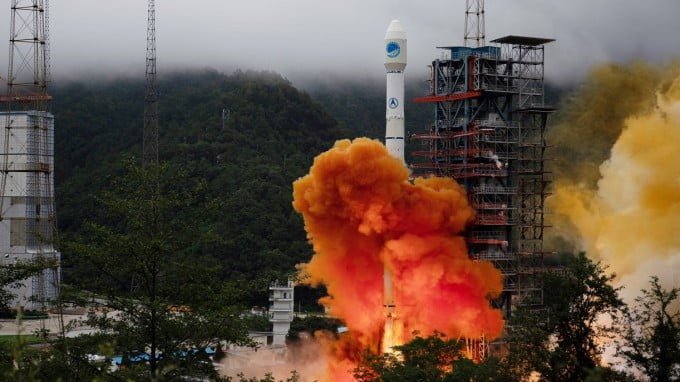China Is Ready for a Space War
On July 21, in 1969, Americans Neil Armstrong and Edwin “Buzz” Aldrin became the first humans to walk on the moon. They were the first of a select group of Americans to be the only humans to do so. Fast forward to more recent times: in May, the world saw America return to launching American’s to space with the SpaceX launch to the International Space Station. Now, in just ten days, NASA will launch its Perseverance rover to Mars, the latest in a fleet of American vehicles on the red planet. The historic anniversary of Apollo 11 and NASA current activities remind us of both America’s dominant history as well as its current dynamism in space.
Under NASA Administrator Jim Bridenstine’s strong leadership, NASA’s long-awaited Commercial Crew Program (CCP) has come to fruition with the May 30 launch of two NASA astronauts to the station and subsequent successful docking—signifying America’s return to putting people into space under its own flag, and not relying on the services of others—especially countries like Russia that are strategic competitors. Moreover, this return occurs with an embrace of the dynamism of the free market. NASA is getting out of the business of putting astronauts and material into low-Earth orbit. Not only can NASA buy these services at competitive market rates from American firms, stimulating a new sector of the U.S. economy, it can now focus on its greater national priority—expanding U.S. access to deeper space—the Moon, Mars, and beyond.
This represents the next generational leap for NASA—Apollo took Americans to the moon, and the space shuttle cemented American leadership in building the International Space Station—but NASA was stuck in low-earth orbit. By transitioning the earth to orbit taxi/freight business to American commercial launchers, it can now take Americans to the Moon, Mars and beyond. This major shift in NASA’s operations gets lost in media commentary, coming at the same time that China’s space program has made great strides.
Chinese announcements come frequently—plans for Chinese landers, Chinese crew on the Moon, new Chinese space launchers, Chinese plans for a space station, and an upcoming Chinese launch to Mars. It all sounds impressive—but let’s remember, as NASA has learned, it is easier to announce plans than it is to accomplish them. In considering most of China’s ambitious plans, it’s worth noting that NASA’s already done all of that—most of it decades ago.
- China on the moon? Let’s look back forty years—NASA put Americans on the Moon in six crewed missions between 1969 and 1972; and is sending Americans back by 2024, with a sustained American presence on the moon through the Artemis program by 2028. Overall, more than fifty missions to the Moon have failed, including recently by an Israeli company. While talking about the Moon is easy, getting to the Moon is hard.
- China plans for space launch? Setting aside its long history, America has revolutionized space launch in recent years through both commercial and government launchers, with SpaceX (and others working on it) re-taking the low-earth orbit launch market and building the world’s current heaviest launcher, the Falcon Heavy, and NASA building the Space Launch System which will be the heaviest still when it launches with a third more lift capability in 2021.
- A Chinese space station? Over twenty years, NASA evolved the U.S. space station Freedom into a U.S.-led international coalition for the $100 billion International Space Station with Russia, Japan, Canada and eleven members of the European Space Agency. The United States shouldered over half of the overall cost of building it, including thirty-six space shuttle missions. It has been continuously manned for almost twenty years (it will be twenty years in November 2020)—with 151 Americans (three times more than the next highest nation, Russia with about fifty).
- A Chinese Mars mission? NASA has had eight successful Mars landers/rovers (Viking I/II, Pathfinder, Spirit/Opportunity, Phoenix, Curiosity and InSight) and launched at least six successful Mars orbiters, including some which have returned exquisite science about the planet—the Mars Reconnaissance Orbiter (MRO) includes the HiRISE (The High Resolution Imaging Science Experiment at the University of Arizona—the powerful HIRISE camera takes pictures that cover vast areas of Martian terrain while being able to see features as small as a kitchen table. Only two nations—the United States and the former USSR—have successfully landed a spacecraft on Mars (and the Soviet lander, Mars 3, failed twenty seconds after landing), and only four have successfully put spacecraft in orbit: the United States, the former USSR, European Space Agency and India. More than twenty-eight missions to Mars have failed—and China will try again this year, after having last tried to reach Mars in 2011. Since then, with three rovers (Spirit, Opportunity, and Curiosity) and one planned for launch in July (Perseverance), Mars has been an American frontier. Getting to Mars is hard, too.
NASA runs the most comprehensive space exploration program of the solar system, with more missions than the rest of Earth combined. For a quick survey of the solar system, NASA’s Mariner 10 and MESSENGER spacecraft are the only missions to have explored Mercury but the European Space Agency’s BepiColumbo is on its way. The United States and USSR both sent missions to explore Venus in the 1960s, 1970s, and 1980s, followed by the European Space Agency and Japan in the 2000s. Mars has largely been an American frontier not only for its rovers but for its orbiters as well, including the Odyssey, Mars Express, Mars Reconnaissance Orbiter, Mars Orbiter Mission, MAVEN, and the Trace Gas Orbiter. Others are launching to Mars this year, with the UAE, India, and China sending missions that could join the Americans there. The only ten missions to Jupiter and Saturn have been U.S. missions, although some required the participation of the European Space Agency, and America is the only nation to send missions to Uranus and Neptune (Voyager 2) and Pluto (New Horizons).
As China is making new developments in space, NASA’s dominance in that region makes it the envy of the planet. In addition to its impressive history, NASA is currently running more than eighty-five active missions to explore the solar system, the Commercial Crew Program is now coming to fruition, it is returning Americans to the moon, and developing the hardware go to Mars. This is happening in addition to NASA’s contributions to the U.S. economy, and to education in America, both of which help make the case for continued investment in NASA and to maintain NASA’s lead over China and other strategic competitors. As China continues its progress, Americans need to remember their country’s historical, current and future dominance in space. This context is important for recalling, especially when it comes to China, that it is easier to plan a mission than it is to achieve the mission’s end goal.
By Shay Stautz
Source: National Interest








One Comment